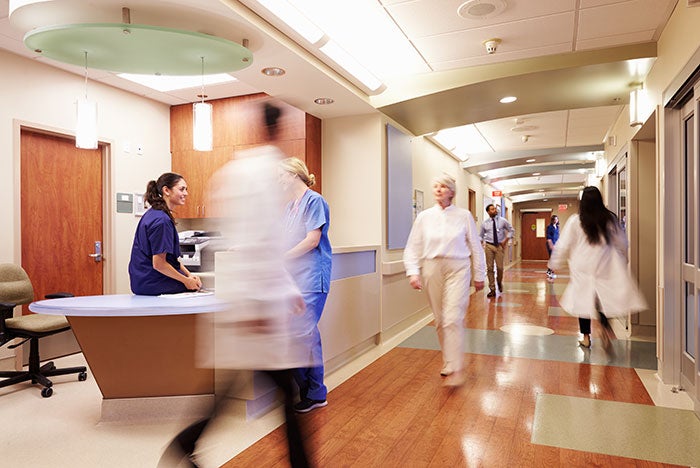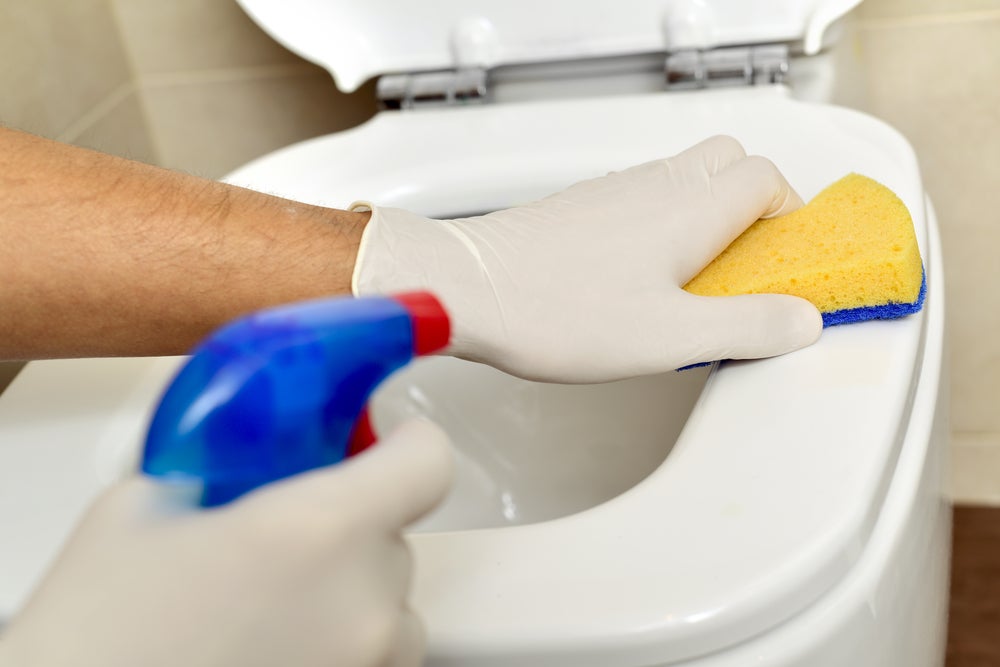Decreasing contagion in high-traffic health care facility areas

Nursing station surfaces like tables and keyboards are potential conduits for infectious pathogens.
In a busy health care facility, high-traffic areas can be reservoirs for infectious pathogens. Surfaces in main hallways, elevators, cafeterias and busy waiting rooms come in contact with dozens of human hands every day, while doorknobs, light switches and elevator buttons likewise are touched frequently.
Nursing station surfaces like tables and keyboards and patient room fixtures like bedrails, tables, IV pumps and even privacy curtains are potential conduits for infectious pathogens.
However, environmental infection-control strategies and engineering controls — principally around routine cleaning and disinfection — can effectively minimize the risks of transmission and infection.
High-traffic pathogens
There are a number of different infectious pathogens that can be found in high-traffic areas, and each poses a different type of transmission risk to patients, visitors and health care professionals alike.
Certain multidrug-resistant organisms (MDROs), such as methicillin-resistant Staphylococcus aureus (MRSA), vancomycin-resistant enterococci (VRE), multidrug-resistant (MDR) gram-negative organisms and Clostridium difficile can be transmitted by direct patient contact or indirect contact with contaminated equipment or various environmental surfaces.
However, because special pathogens such as C. difficile and Norovirus can be even more difficult to eliminate, they require particularly careful attention.
Norovirus outbreaks in particular have been noted in many settings. Health care facilities, in which high-traffic areas can pose the greatest risk of transmission, are especially noteworthy environments. On average, there are between 19 and 21 million cases of Norovirus annually, according to the Centers for Disease Control and Prevention (CDC).
More commonly dubbed the “stomach bug,” Norovirus is known to cause gastroenteritis outbreaks around the world, and is primarily transmitted via the fecal-oral route. This virus, which infects the stomach or intestines, is hardy enough to linger on surfaces and objects for an extended period. Because it is capable of remaining quite stable in the environment, Norovirus tends to be particularly difficult to eliminate, the CDC states.
The high-traffic areas pathogens frequent can be further broken down into a few location groups: facilitywide, unit-based or within a patient room. Each has different high-touch areas and, therefore, poses different transmission risks.
You may also like |
| Automated disinfection systems |
| Disinfection products for today’s challenges |
| Focus intensifies on UV disinfection research |
|
|
For example, surfaces in main hallways, on door handles, elevator buttons, computer equipment and telephones in a health care facility may pose less of a risk for C. difficile transmission than those in a patient room, where the surfaces of handrails, bedrails, toilets and faucets must also be cleaned and disinfected.
Even though the surfaces outside a patient's room may become contaminated with C. difficile spores, it would typically be at a much lower rate than on surfaces within a patient's room, according to an Infection Control & Hospital Epidemiology report.
A new meta-analysis study showed a high rate of S. aureus contamination on high-touch items in the health care setting, and mobile phones to be the most frequently contaminated high-touch device, according to a report in the April 2017 issue of the American Journal of Infection Control.
Some bacteria can survive for months on the surface of a dry touch-screen device, and the risk of contamination is amplified by the fact that 86 percent of clinicians and 76 percent of nurses use smartphones while at work. The prevalence of these devices emphasizes the importance of hand hygiene, routine cleaning and proper disinfection, which are the only effective means of minimizing or eliminating the risk of pathogen transmission. In the event of a Norovirus outbreak, for example, increased cleaning and disinfection would be crucial to reducing the possibility of prolonged fecal-oral transmission.
There is evidence that the pathogens previously described can colonize the hands of health care personnel and patients and be transmitted to others, leading to outbreaks of disease. A May 2016 American Journal of Infection Control article, "Monitoring and improving the effectiveness of surface cleaning and disinfection," found environmental contamination to be just as likely to cause a spread to the health care provider’s hands as direct contact with patients.
Cleaning and evaluation
Routine cleaning with the appropriate cleaning or disinfecting agent(s) is the best practice for decreasing the risk of contagion in high-traffic areas, according to the CDC's 2008 Guideline for Disinfection and Sterilization in Healthcare Facilities.
According to the report, surfaces should be cleaned routinely — as well as when dirty or soiled — to provide an aesthetically pleasing environment and to prevent potentially contaminated objects from serving as a source of health care-associated transmission and infection. Because environmental surfaces can act as important reservoirs for significant MDROs and other pathogens, it is critical that health care facilities establish a consistent cleaning and disinfection process with appropriate products and that all personnel are properly trained and invested.
It is also crucial to evaluate the condition of environmental surfaces and materials. Barrier-protective coverings on a variety of surfaces are touched frequently with gloved hands during the delivery of patient care, and can become contaminated. From the outset, such surfaces are challenging to clean or disinfect thoroughly. If they are damaged or no longer intact due to significant scratches, tears or holes, thorough, effective cleaning is all the more difficult to execute. Too often, facilities continue to try to clean and disinfect such damaged surfaces, which can act as potential reservoirs for pathogens. The only solution is to repair or replace them, and to clean the new surfaces properly.
These practices — and the frequency of their implementation — can and should be tailored to a facility's particular needs, which are always likely to be in a state of flux. For example, if a health care facility is having an outbreak of C. difficile or Norovirus, a bleach solution is preferred for all cleaning, and the frequency would need to increase beyond the normal rate when there is not currently an outbreak.
A facility with a higher rate of health care-associated infections (HAIs) would likewise want to increase how often it is cleaned and disinfected throughout, with a particular emphasis on targeting the high-traffic areas that tend to be breeding grounds and points of transmission for pathogens. Thorough patient room turnover and terminal cleaning are also valuable, the CDC advises.
In 2004, the Johns Hopkins Hospital noted a significant Norovirus outbreak at its tertiary care hospital in Baltimore [see sidebar at left]. Multiple infection-control interventions were deployed. Clear cleaning instructions outlining the appropriate frequency and location or surface were incorporated and implemented by environmental services personnel. Eventually, the outbreak was contained. However, this was not without substantial financial cost and danger to staff and patients.
As the Johns Hopkins experience illustrates, ongoing quality assurance is important. Facilities consistently should review the quality and effectiveness of their cleaning processes, and ensure that patient room turnovers and high-traffic areas are cleaned appropriately. If not, they are at a disadvantage, and may face more issues with outbreaks or HAIs as a result.
The CDC offers tools to help assess cleaning and disinfection practices. As with any process, constant evaluation of cleaning and disinfection procedures must take place. By evaluating data that review both visual impressions of cleanliness and whether contaminants continue to proliferate, environmental services personnel can amend processes as needed to drive improvement.
The 2011 CDC Guideline for the Prevention and Control of Norovirus Gastroenteritis Outbreaks in Healthcare Settings has specific recommendations for routine environmental cleaning and disinfection in clinical and high-traffic areas.
Frequently touched surfaces (especially toilets, faucets, handrails, bedrails, telephones, door handles and computer equipment) are recommended to be cleaned and disinfected with increased frequency — three times per day at minimum — in the event of Norovirus outbreaks. During a health care facility outbreak of Norovirus, it is critical to follow cleaning and disinfection guidelines to control transmission effectively.
These are only general guidelines as to how frequently high-traffic areas that pose risks for contagion should be cleaned, because there always will be inconsistencies and varying practices from one facility and point in time to another. More guidance on the specifics of a given environment, and all mitigating factors that point to the degree of risk, will help cleaning processes to become more consistent and effective. Environmental surfaces that are frequently, consistently touched inevitably will be reservoirs for pathogens, and it will be a continual challenge to keep these areas completely free of germs.
Appropriate and thorough cleaning methods can reduce the spread of infectious pathogens in and around high-traffic areas, while also cutting costs and broader health risks to medical staff, visitors and patients. High-traffic areas, including main hallways, elevators and cafeterias containing high-touch surfaces like handrails and doorknobs, all should be cleaned and disinfected routinely with the appropriate materials to reduce the risks of contamination to the fullest extent possible.
Minimizing outbreaks
With adequate knowledge, preparation, clear communication and aggressive, appropriate cleaning measures, health care facilities can do a great deal to minimize the risks of outbreak and maximize the healing experience of patients and visitors who cross their doors.
Only in the future, if environmental services professionals garner other resources that rely on engineered controls to evaluate and automate the environmental surface-cleaning process in lieu of human judgment might they be able to alter this approach.
Deva Rea is clinical science liaison for PDI Healthcare, Orangeburg, N.Y.



